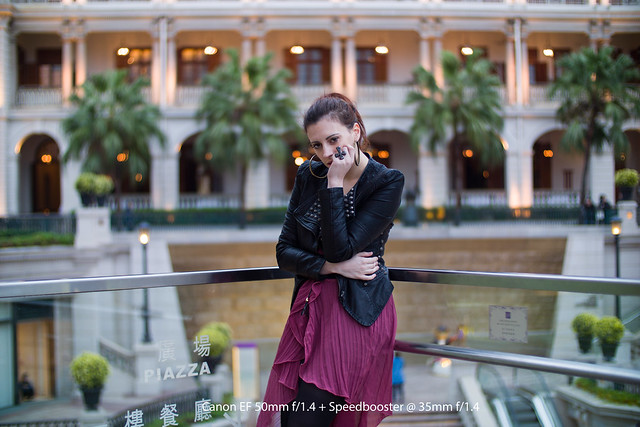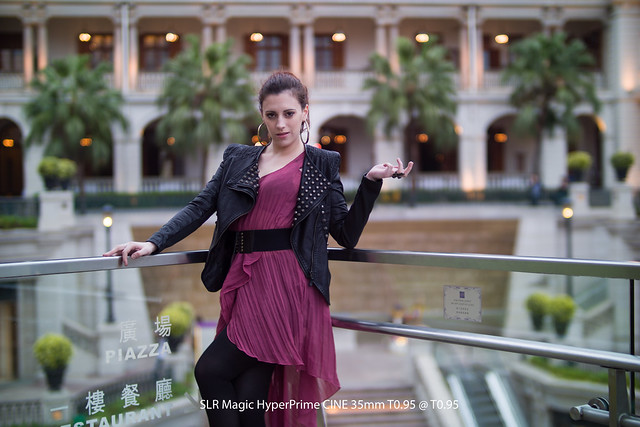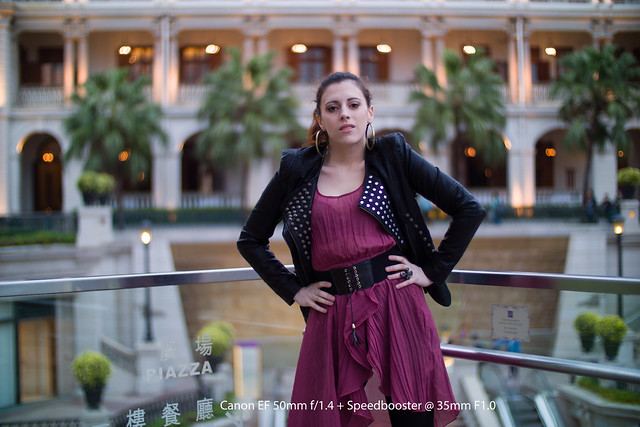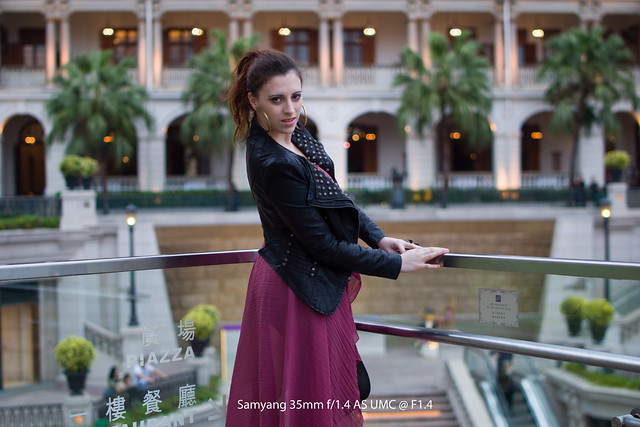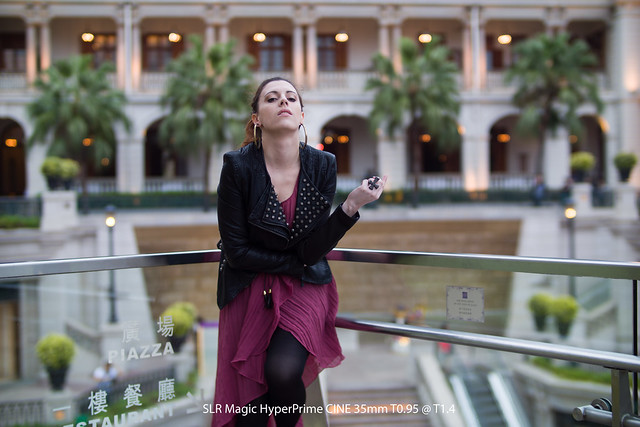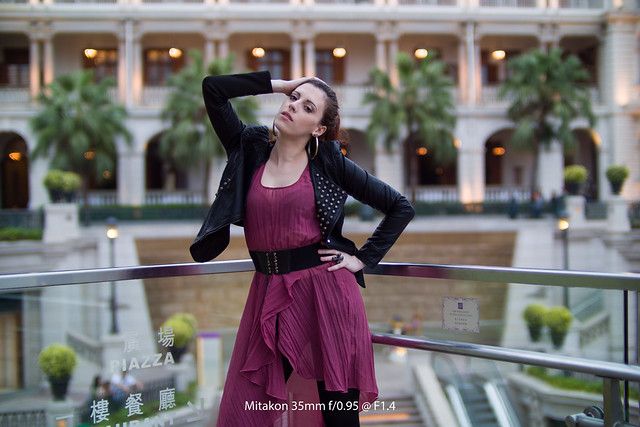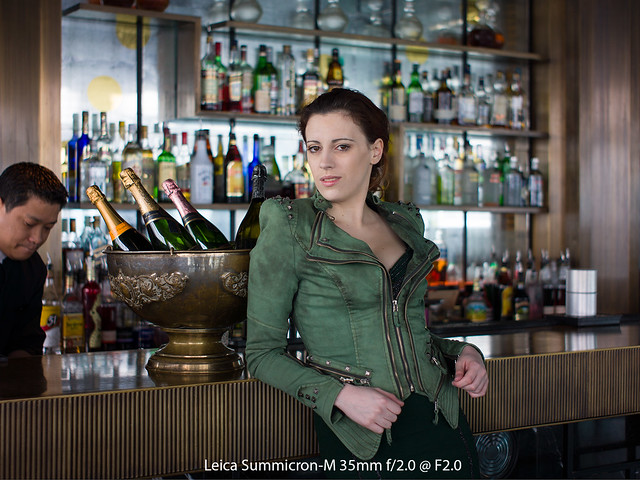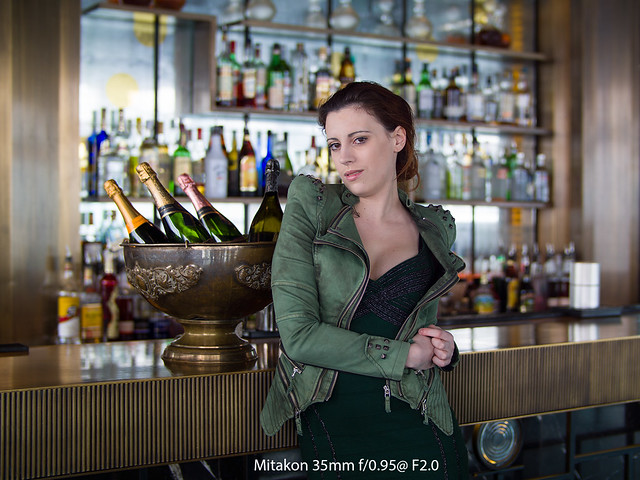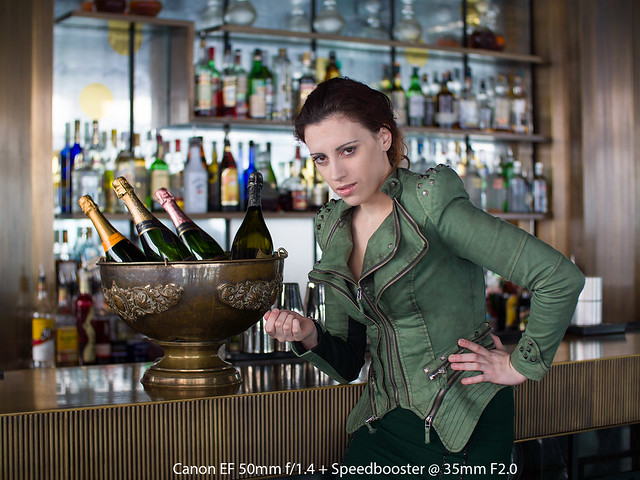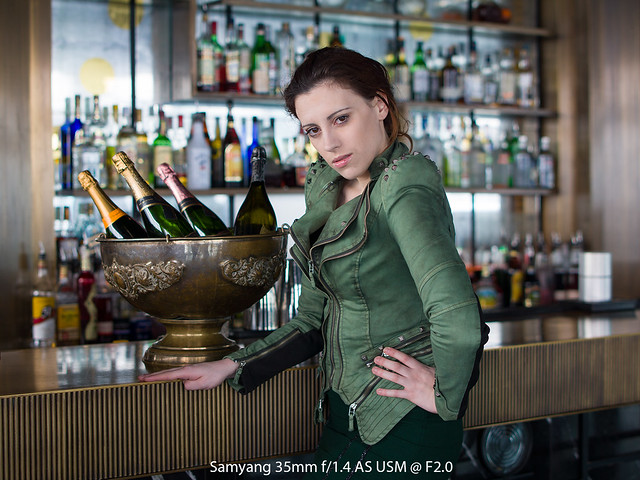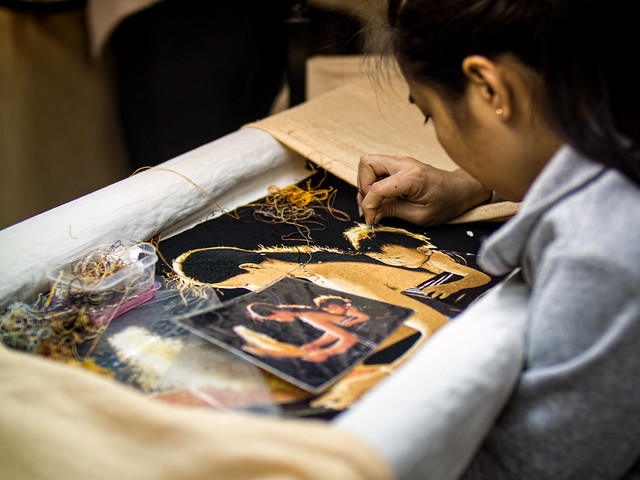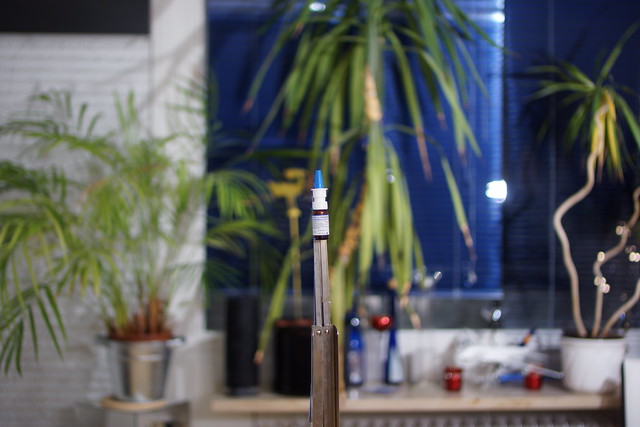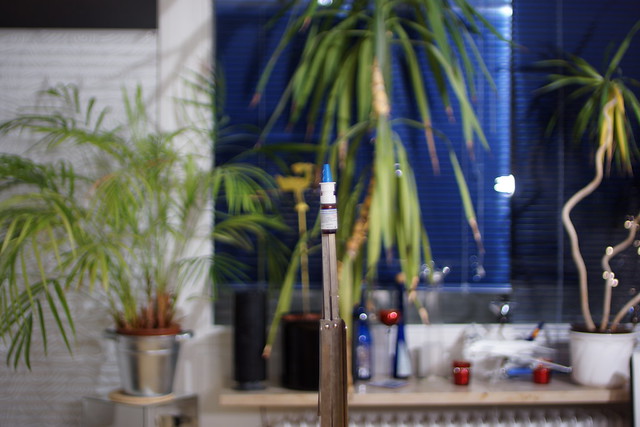March 2013 - Back in February I had another opportunity in Hong Kong to compare quite a unique collection of superfast 35mm prime lenses that - attached to a NEX-7 - provide you an equivalent angle of view to a classical 50mm lens on full frame. Three of them start at an amazing aperture of about f/0.95 that compares in terms of depth of field (DOF) to 50mm f/1.4 on a fullframe sensor.
One of the candidates, the SLR Magic HyperPrime CINE 35mm T0.95 was compared already in December 2012 to a Voigtländer Nokton 35mm
f/1.2 ASPH (version I) and an AF-S Nikkor 50mm f/1.4 G on full frame (the Nikon D800E) (here, in memory), thus triggering a discussion about onion rings ...
The shootout candidates (ordered by transmission / aperture):
- SLR Magic HyperPrime CINE 35mm T0.95
The final production version used in this comparison will start shipping in about May 2013 for an introductory price of US$ 1249. It is a very solid (about 800g) construction with 12 lens elements, circular aperture blades and an extractable lens hood. The aperture ring operates clickless and is calibrated in T-stops (a transmission of T0.95 usually requires an aperture of about f/0.9 to f/0.92) and has the same cogging like the focus ring to support video applications (follow focus) as well. It is shipped with M-mount and an adapter to E-/X-/EF-M-Mount depending on your order. It covers APS-H sensor size but with its large rear element (diameter 36mm) it does not fit into the throat of current Leica-M cameras or Ricohs GXR module. For more details please see this article. - Mitakon 35mm f/0.95
This lens is a very solid construction as well with 10 lens elements and a 10 blades aperture. It has good haptics, weighs about 680g and comes with E-mount. Prices I have seen so far varied between 700 (eBay auction) and 1000 US$ (private auction). The lens is manufactured in China and until now I did not see a dealer that offers it with warranty. - Canon EF 50mm f/1.4 lens + Metabones Speed Booster (converting to a 35mm f/1.0 lens)
This combination of a 50mm f/1.4 full frame lens and a focal converter provides you a lens with 35mm focal length and an aperture of f/1.0 still covering the size of an APS-C sensor. To understand that functional principle please see Metabone's white paper. The adapter is designed to transmit /convert also the electrical signals to the lens in order to control aperture setting and autofocus (on selected lenses) by the camera. The Canon EF 50/1.4 lens is about 400 US$, the adapter costs about 600 US$ when ordered in Hong Kong. - Leica Summilux-M 35mm f/1.4 ASPH
This lens is designed with 9 elements, one with aspherical surface and 9 aperture blades. It is very compact and weighs only about 320g. Some people say it is still the "35mm/1.4 reference". Prices are about 5000 US$ (new and about 4500 US$ used). - Samyang 35mm f/1.4 AS UMC
This lens is designed for fullframe DSLRs and constructed with 12 lens elements (some aspherical) in 10 groups and an aperture with 8 blades. It weighs about 712g. It is availabe with different mounts and has an attractive price of about 500 US$. - Leica Summicron-M 35mm f/2.0 ASPH
This even more compact desgined lens is propably the smallest 35mm f/2.0 fullframe lens avaiilable today. It is designed with 7 elements (one aspherical surface), has an 8-bladed diaphragm and weighs 254g. Price is about 3200 US$.
In this article we will cover
- overall comparison
- center-sharpness of the f/0.95 and f/1.4 candidates at open aperture and F1.4 as well as edge sharpness (of the 0.95 candidates)
- bokeh (rendering of the out-of-focus areas and the shape of the circles of confusion of highlights) at F0.95, F1.4 and F2.0
- conclusion
- further sample shots
Acting as a good subject for real world photos, we met Bertille Tabourot, who is a stylist
and fashion designer from Paris, living currently in Hong Kong. She used this opportunity to present some of her fancy
creations acting as a freelance model.
Overall Picture Comparison at F0.95 / T0.95
The following pictures were all shot from the same position (with about 3m distance to the model) on a cloudy afternoon at a time, where already the first lights on building arcades started providing a nice "available light" mood. The images were developed from RAW with identical settings for sharpness, contrast, clearness etc. You can click on the images in order to open higher resolutions (including the original 24 MP resolution) and from there you can also navigate to the EXIF-data but we will also discuss 100% crops with actual pixels in the next paragraph.
Let us start with the SLR Magic HyperPrime CINE 35mm T0.95 at open aperture:
Mitakon 35mm f/0.95 at open aperture:
Next image shows how the Canon EF 50mm f/1.4 + Speed Booster converting to 35mm F1.0 renders this scene at open aperture:
Center sharpness comparison (F0.95 / T0.95)
During this sequence the camera could be kept at base ISO and shutter times between 1/80s and 1/125s (from tripod in a sequence with 2-3 shots). This allows to get an impression about sharpness and contrast that can be reached with these lenses in a real world situation with a lively scene. It's the way how I use fast lenses and how I prefer to compare them as well instead of shooting boring MTF test charts.
100% crops (actual pixels):
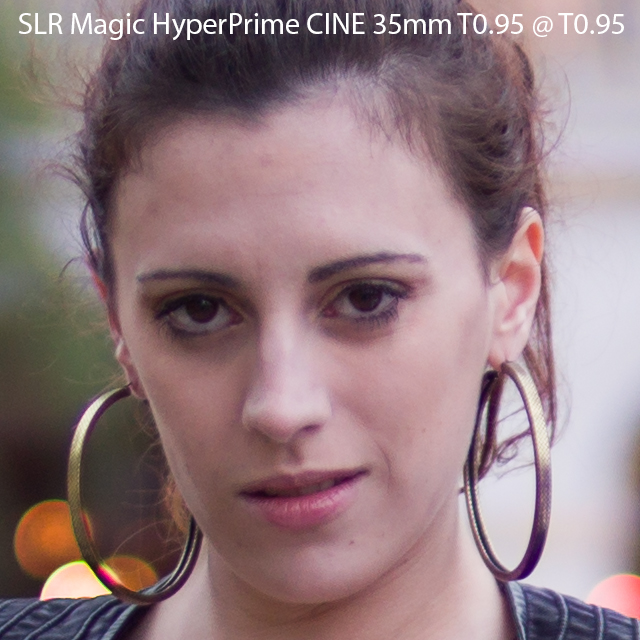

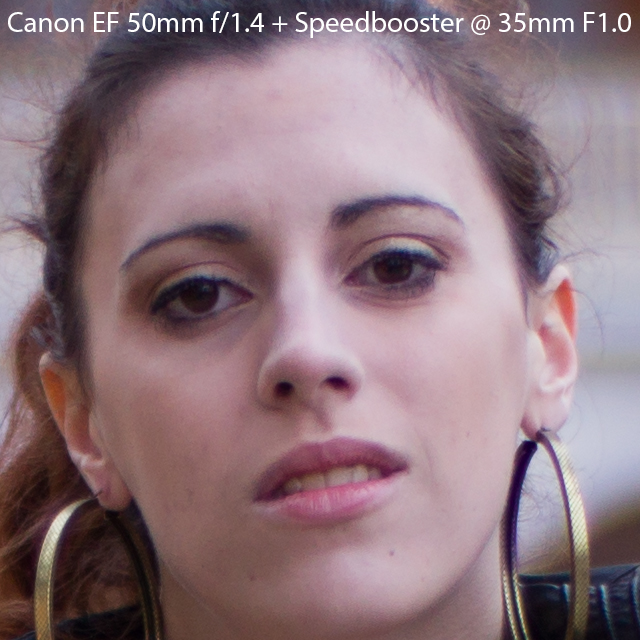
All three candidates provide good center sharpness and contrast already at this extremely wide open aperture. The Mitakon as well as the combination of Canon EF + Speed Booster show some PF / CAs at metallic objects and intersections with high contrast.
Before we come back later to the edge sharpness, let us take a look at the bokeh which is at least as important for me as sharpness when shooting wide open.
Bokeh comparison (F0.95 / T0.95)
When looking at the "bokeh", not only the smoothness of structures in the out-of-focus areas is important - also the rendering of the circles of confusion produced from punctual highlights out there in the background are a weightily criteria for "bokeh-maniacs" like me. So let us compare it at different points in the pictures with 100% crops (actual pixels):

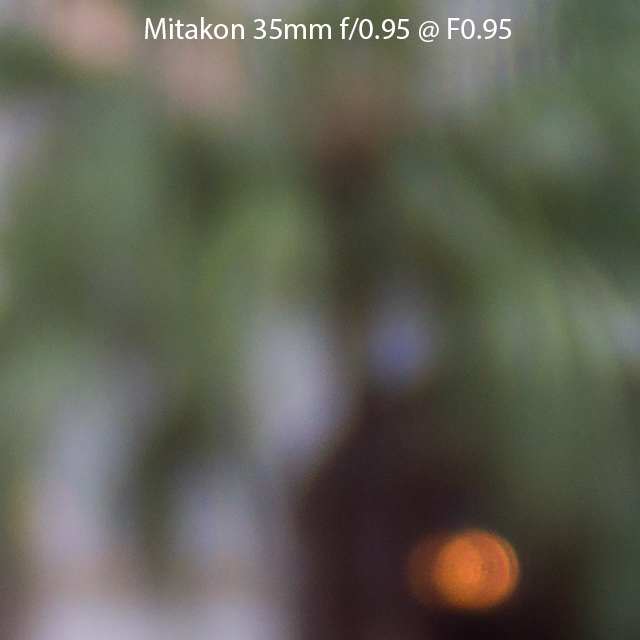
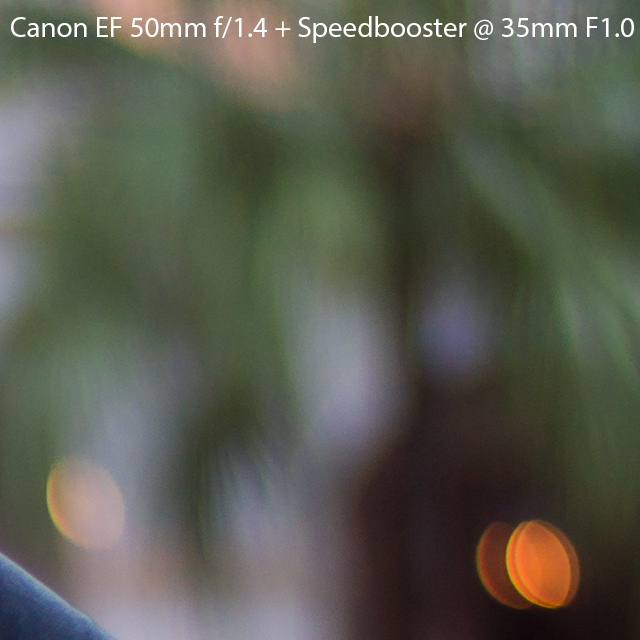
Both the HyperPrime and the Mitakon draw in this area a very creamy bokeh, the HyperPrime shows the most neutral circles of confusion resulting from the background-highlights. The bokeh of the Canon EF + Speed Booster is more nervous and unsteady but I believe (from other comparisons with and without Speed Booster) that this is mainly caused by the Canon lens.
Now let us look at a less central part of the background:
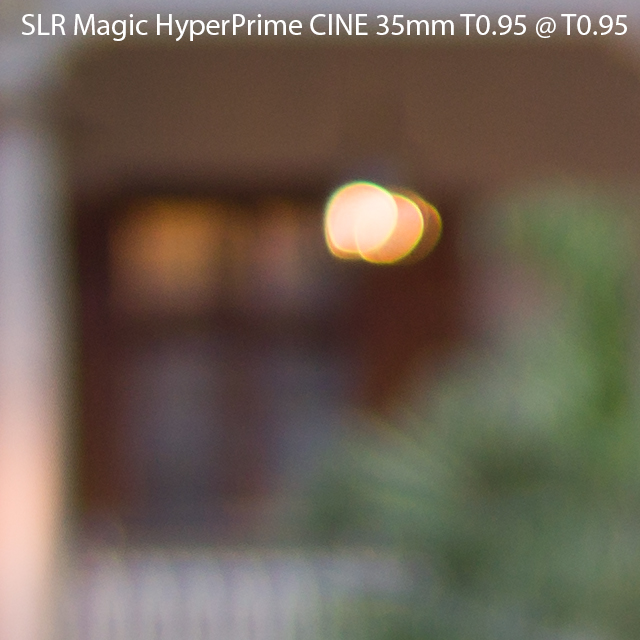
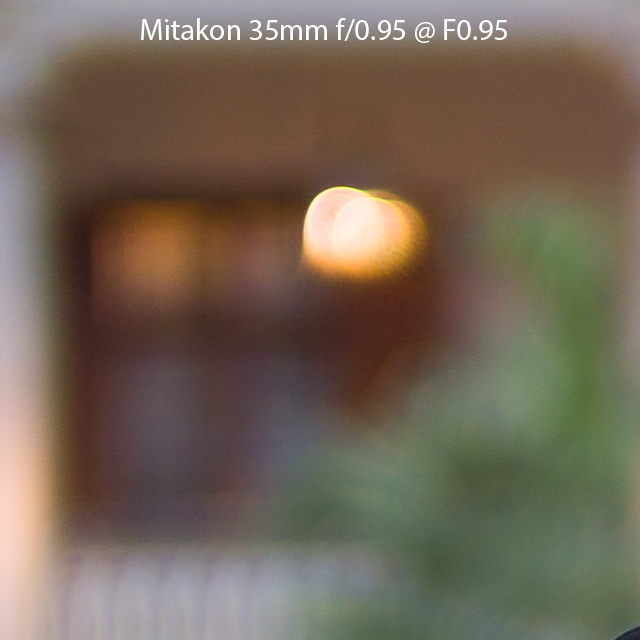
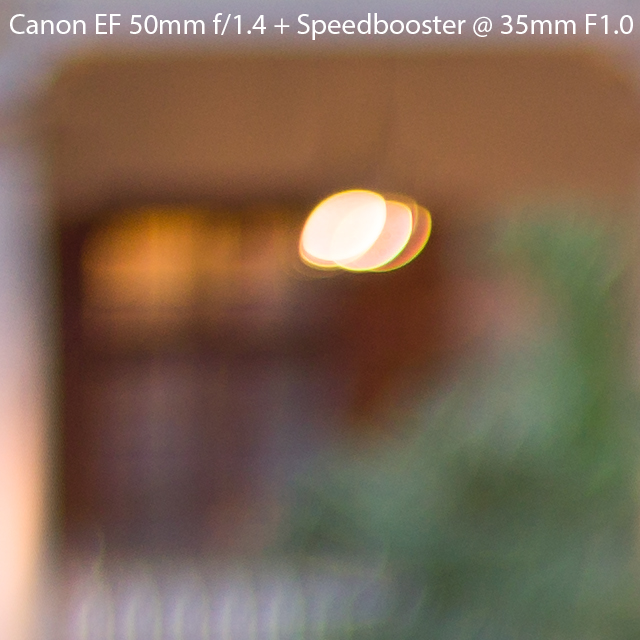
In this off-center area, the HyperPrime continues to show a smooth bokeh with only little deformed circles of confusion, while from the Mitakon the circles of confusion already frazzle a little bit. The combination of Canon EF + Speed Booster shows quite turbulent structures and elliptical shaped blur circles.
If we look at areas further lying towards the edges...
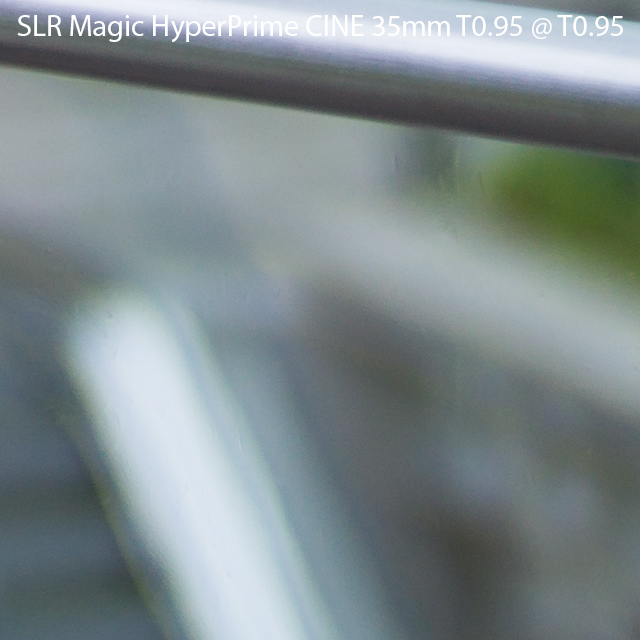
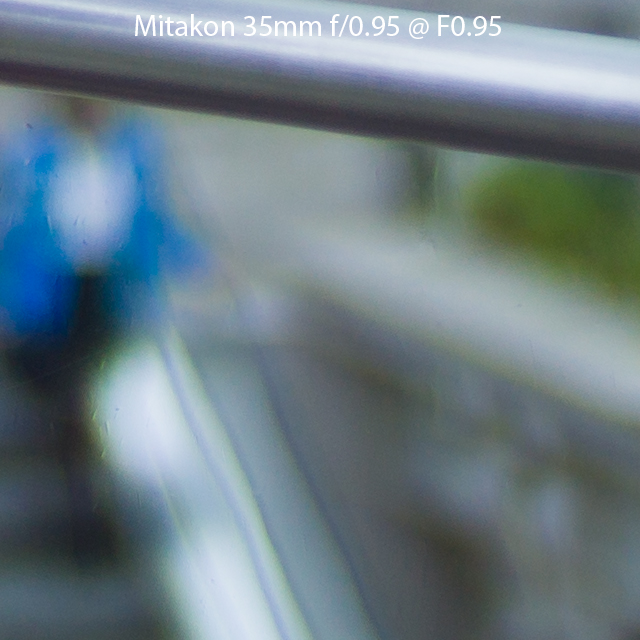
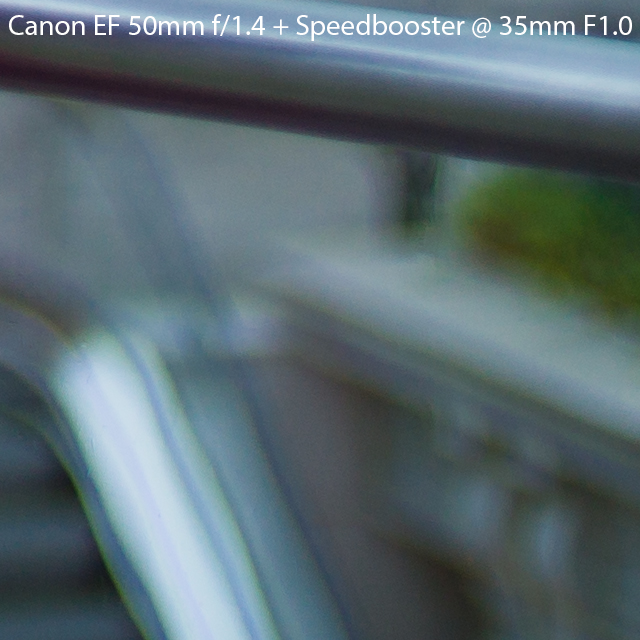
...we can see that the bokeh of the Hyper Prime stays silky here as well, while the bokeh of Mitakon here (by disregarding the person entering the escalator) shows significantly more unsteady structures and some vignetting is perceptible. The Canon EF + Speed Booster vignettes as well and in this area show pretty much edgier structures.
Before we compare these and two other lenses at F1.4, let us take another look at the corners.
Edge sharpness at F0.95 / T0.95
When shooting portraits at open aperture you usually will have the edges in the out-of-focus area but what happens, when the sharpness of the edges becomes important? In order to avoid the impact of field curvature at short distances and shallow DOF, in the following examples the maximum focus magnification (11.7x on the NEX-7) was moved to the edges and focus was adjustet to look as sharp as possible there. The following images are 100% crops (actual pixels) from the lower left edge where a brochure with very small letters was placed:

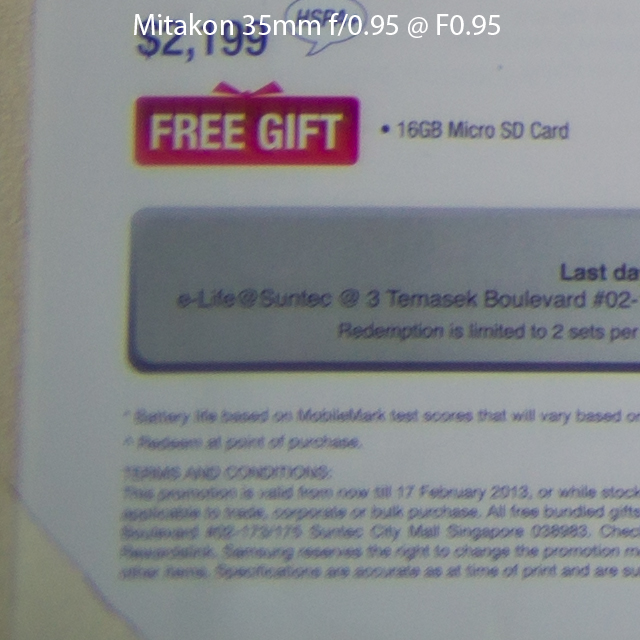
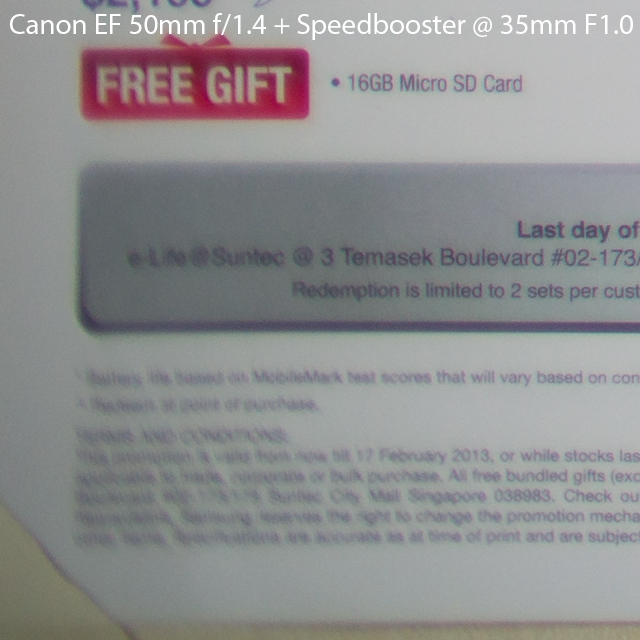
In the corners you see how the effort of the twelve lens elements design and the APS-H coverage of the HyperPrime CINE pays out compared to the ten element design of the Mitakon - which explains also the different sizes of those lenses.
The even more blurry corners of the Canon EF + Speed Booster seem to be mainly caused by the Canon EF 50/1.4 lens which needs to be stopped down to at least F5.6 in order to get edges sharp. So in order to show the portion of blur that Metabones Speed Booster adds in the edges, I took another photo of a newspaper where the camera was set to F5.6 (resulting in a F8.0 setting on the lens when the Speed Booster translates it through the adapter's eletronics):

(please click on the image in order to open the original size (100% view))
If you zoom and scroll to the edges, you see only a little bit of blur remaining - this time giving you an idea which amount of edge blur is added by the Speed Booster.
Overall Comparison at F1.4 / T1.4
At F1.4, two more candidates enter the game. Again you can click on the images in order to see other sizes including the original 24 MP resolution but 100% crops will follow as well.
We start the overview with the Leica Summilux-M 35mm f/1.4 ASPH - unfortunately the shots were taken short before the additional lights in the background were switched on, so that this photo has a slightly different light mood:
Next new candidate is the Samyang 35mm f/1.4 AS UMC:
...followed by the SLR Magic HyperPrime CINE 35mm T0.95 @ T1.4:
...the Mitakon 35mm f/0.95 @ F1.4:
...and the Canon EF 50mm f/1.4 + Speed Booster @ 35mm F1.4:
Sharpness at F1.4 / T1.4
These are the 100% crops (actual pixels) from the focused area:

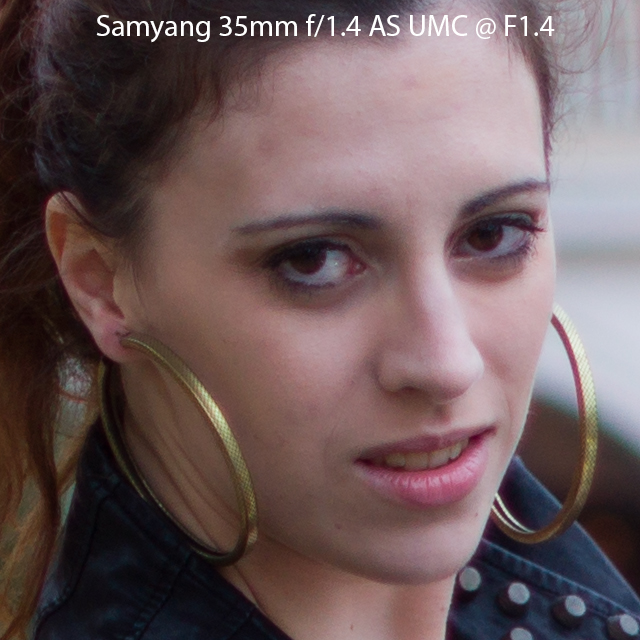
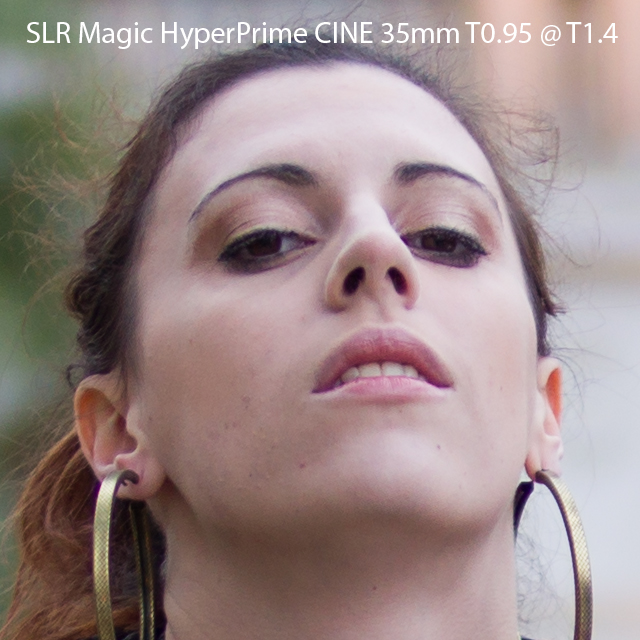
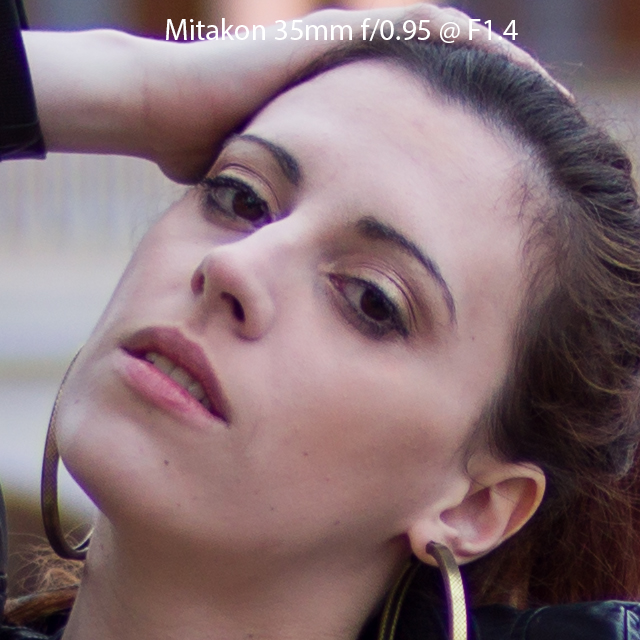
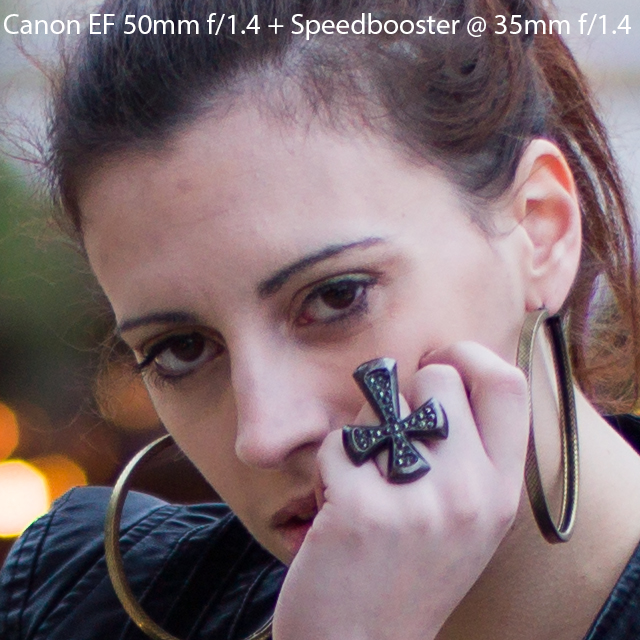
At F1.4 all candidates do a good job in terms of sharpness. The Mitakon still shows a slight tendency to PF / CAs also at F1.4. In the Canon EF shot you see that the background highlights already turn to octagons showing the shape of the eight aperture blades.
Bokeh comparison at F1.4 / T1.4
Now let us take a look at 100% crops (actual pixels) from the background blur:
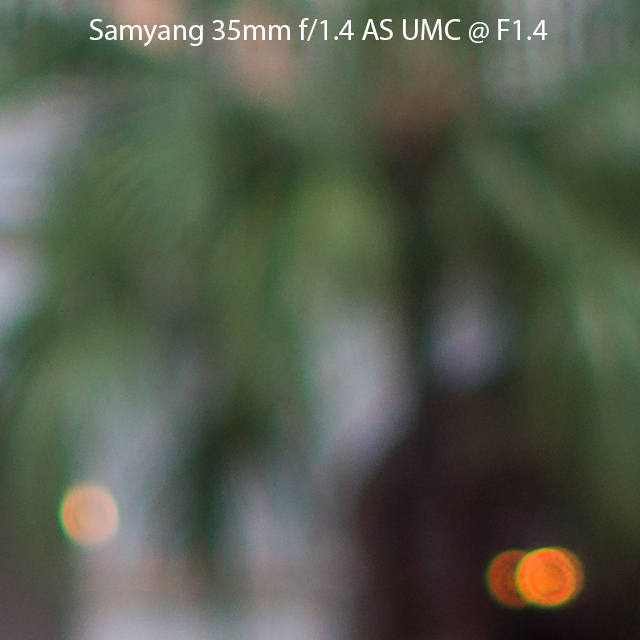
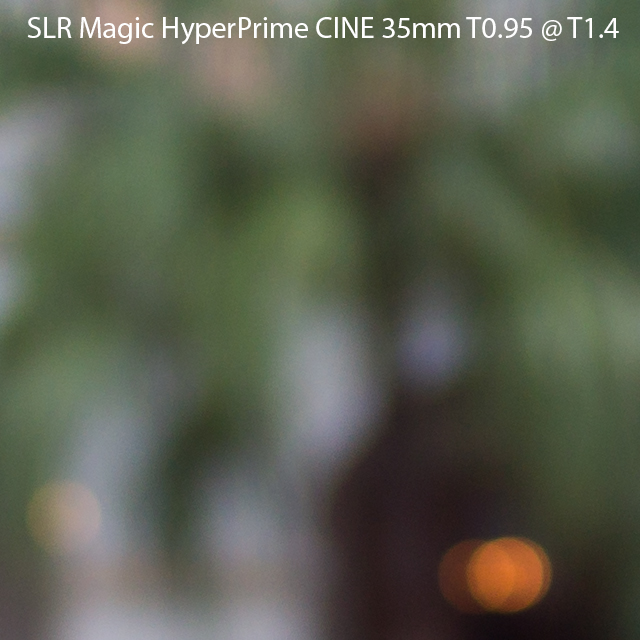
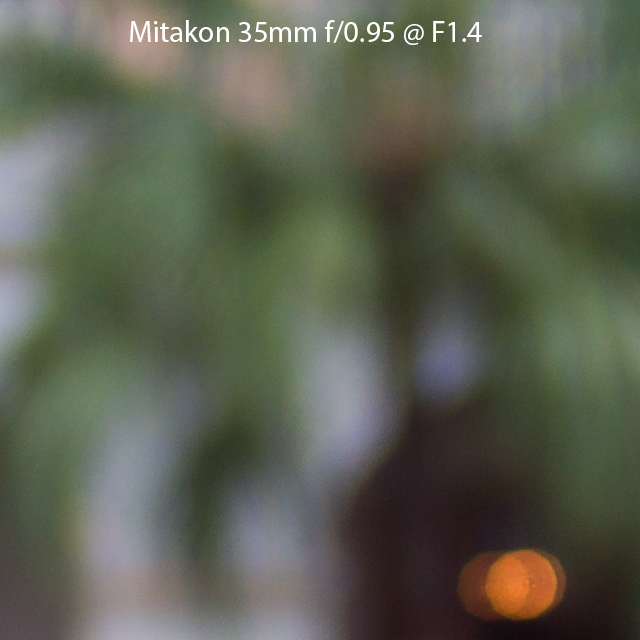
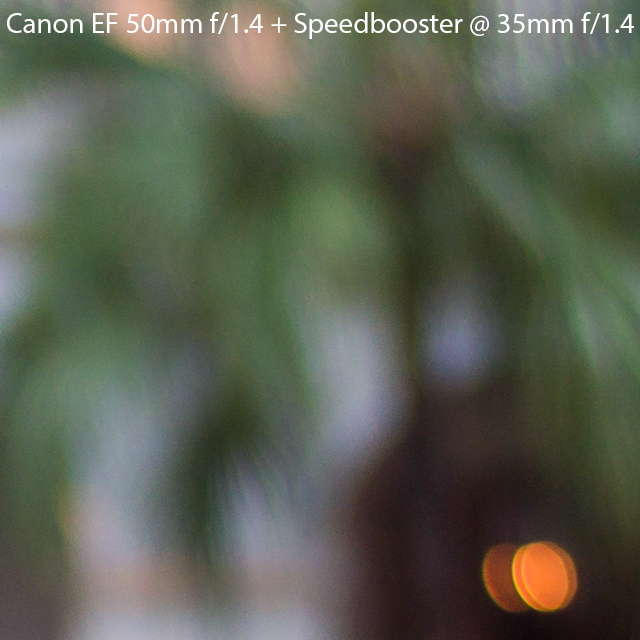
Interestingly, here the bokeh of the Leica Summilux-M ASPH and the Samyang look quite similar. Both are fairly smooth but not as creamy as the bokeh of the HyperPrime CINE and the Mitakon. The combination of Speed Booster and Canon EF 50/1.4 shows a more twitchy rendering of the out-of-docus areas, the light-scattering circles are more deformed and - as mentioned in the sharpness comparison before - the circles turn into octagons. Stopped down, the HyperPrime CINE still preserves almost round circular shapes of the highlight diffraction, while the 10 aperture blades of the Mitakon become already visible at F1.4.
For the Speed Booster it should be noted at this point that when stopping down, the images were overexposed by about one stop, so the camera had to be set to compensate this. The autofocus did not work with our sample in combination with the Canon EF 50/1.4, although we tried two different copies of the lens.
Comparison at F2.0 / T2.0
As in this initial scenery the out-of-focus area of the background can not be rendered smooth enough anymore at F2.0 (for my taste), I decided to demonstrate it only for the Leica Summicron-M 35mm f/2.0 ASPH that otherwise would not have been considered in this part of the shooting. Overview:
100% crop (actual pixels) from that image (with some gentle skin retouche):

100% crop from the background:
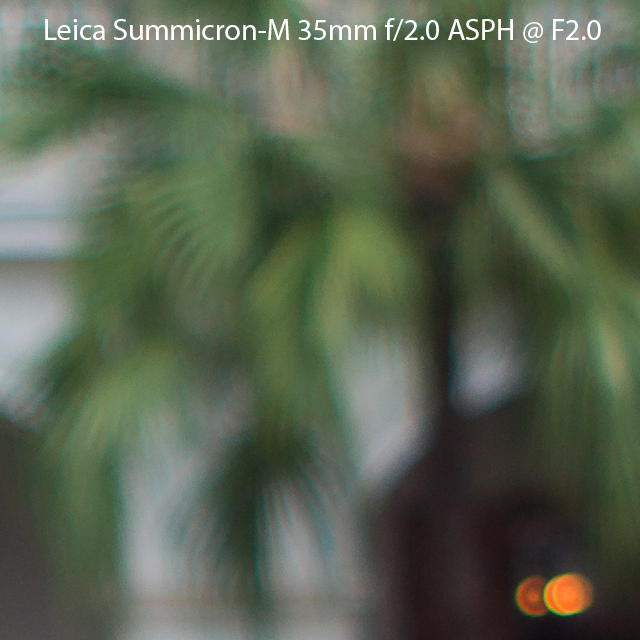
This crop propably explains why at this setting the background already draws too much attraction because the fine structures can not be blurred enough anymore. The model in the foreground can not pop out from the background like it was possible at F1.4 or F0.95 with the other lenses.
So we choosed a different scenery and a setup, where the camera was positioned closer to the model, allowing to apply more blur to the background through the closer focus distance.
You can still click on the overview images in order to open larger sizes but this time they have a reduced resolution showing the full screen picture, how it was meant for a PC screen. By applying an optimized sharpness transformation, minimal motion blur of the (very patient!) model that could appear at 1/60s in original resolution is eliminated and the images get more "pop". After you have seen the shots of the previous setup, none of the lenses have to proof anymore that they are sharp at F2.0. So just compare them primarily for their style of rendering the background, gradient of smoothness, colors etc.:
To be honest, all lenses do a very similar job here at F2.0. It makes no sense to compare 100% crops here as the differences are far less obvious than in the first sequence. Also here F0.95 to F1.4 has been my favored aperture setting, to get an optimum DOF balance of sharpness on the model and background blur. You can see what I mean, when you scroll back to the title image that was shot with the SLR Magic HyperPrime CINE 35mm at T1.4.
Conclusion
The first thing I learned myself from this comparison was, that for half to full body portraits, on an APS-C image sensor you should choose a 35mm lens that allows an aperture setting of at least F1.4 in order to get the DOF shallow enough for a nice out-of-focus blur in the background and some "3D pop" for the model in the foreground.
At F0.95 (or F1.0 for the Speed Booster combination or T0.95 for the HyperPrime CINE), for me the SLR Magic HyperPrime CINE is the winner of this shootout. Center sharpness and bokeh of the Mitakon is about comparable but the more it comes to the borders and edges, the more you can see the advantage of the more complex design of the HyperPrime CINE. Also the coating of the HyperPrime lens elements seems to be of a higher grade as it shows significantly less purple fringing and CAs compared to the Mitakon. This test also proves that we are talking about different lens constructions - disproving many assertions on the internet, that SLR Magic just rebarrels and resells the Mitakon lens under its own label.
The Speed Booster seems to do a good job in optical terms but in this test the weak point was the Canon EF 50mm f/1.4 mounted on the Speed Booster as the bokeh quality was far behind the Mitakon and the HyperPrime CINE and the edges are smearing too much. In electrical terms, the Speed Booster could not convince me with that lens as well. The autofocus did not work at all although we tried two different copies of the Canon lens and the NEX-7 needed some exposure compensation (about one F-stop) when stopping down the aperture. Hopefully this can be fixed through firmware updates for the adapter. Metabones, when you read this, please let me know when this got fixed and of course, please let me know when your version of that adapter becomes available for lenses with Nikon F-mount ;-)
At F1.4 all candidates showed good sharpness and contrast but the Mitakon still produced some PF / CAs. The bokeh quality of the HyperPrime CINE and the Mitakon convinced me more than the bokeh of the Leica Summilux and the Samyang. The tail lamp again carried the Canon EF lens when it comes to bokeh. Notable is again that the HyperPrime CINE keeps the shape of its iris still almost round when stopped down resulting in nicely round circles of confusion from the punctual background highlights.
The SLR Magic HyperPrime CINE as well as the Mitakon and the Samyang all deliver a good value for their price. The Leica lenses may show more advantages when compared on fullframe and it is always amazing to see how compact they can build top quality fullframe lenses. The Speed Booster can be a good investment when you still have a large collection of fullframe DSLR lenses of one and the same system and want to continue using them at the same angle of view and DOF as on fullframe but I hope their coverage of electronic functionality will be increased in the future.
Finale
Let me close with some shots taken on my trip to Southeast-Asia demonstrating the picture language that can be spoken with a superfast 35mm lens on a Sony NEX-7. All these examples were taken with the HyperPrime CINE 35mm T0.95 at open aperture:
After acquiring a copy of the new Voigtlander Nokton 35mm f/1.2 ASPH II (version 2), I did a short comparison to it's predecessor (version 1) and the SLR Magic HyperPrime CINE 35mm T0.95.
Here you can find the results:
Voigtlander Nokton 35mm f/1.2 ASPH version 1 @ F1.2:
100% crops (actual pixels):
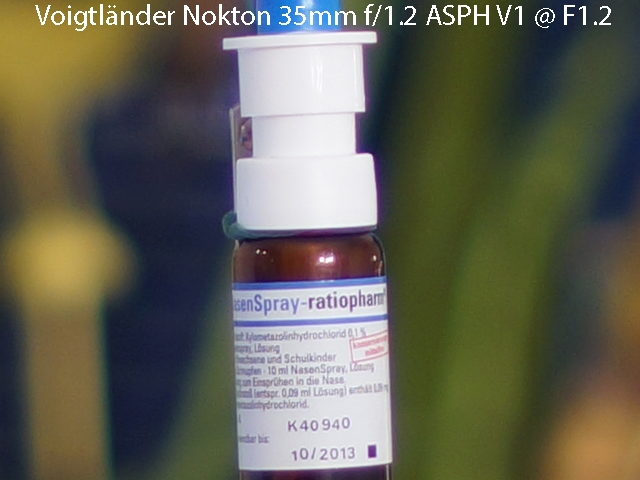

Voigtlander Nokton 35mm f/1.2 ASPH II (version 2) @ F1.2:
100% crops (actual pixels):


SLR Magic HyperPrime CINE 35mm T0.95 @ T1.3 (about f/1.2):
100% crops (actual pixels):
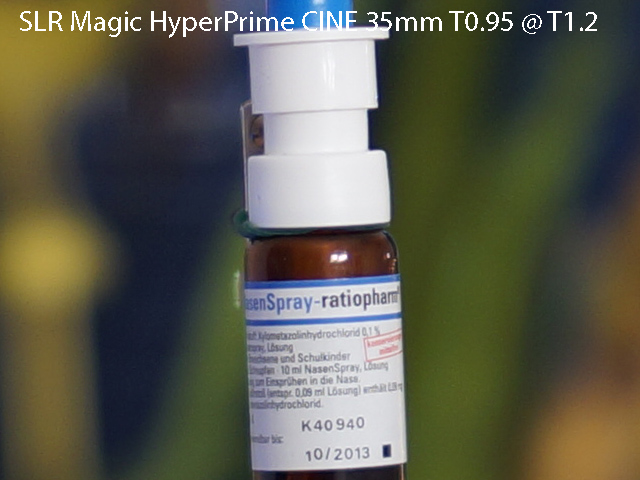

If you want to see more pictures from this test (the HyperPrime also tested at T0.95 and all three lenses tested at F2.0), please check this Flickr album.
As a result I would prefer the older version I of the Nokton 35mm f/1.2 ASPH over its successor (version II) due to its better sharpness and contrast wide open even though the circles of confusion in the out-of-focus areas of the older Nokton show "onion rings". The best result also here produces the HyperPrime CiNE with even better sharpness & contrast than the Nokton version I and much smoother bokeh.
References / additional information:
If you are interested to learn more about Andrew Chan's passion for lenses, I recommend reading this interview: http://japancamerahunter.com/2013/02/insider-interview-andrew-chan-of-slrmagic/
HyperPrime lenses can be ordered at http://www.slrmagic.com/products.php. If you do not find the lens you are interested in, simply contact support (at) slrmagic.com by e-mail.
The facebook homepage of the stylist Bertille Tabourot supporting this comparison as a freelance model can be found here: http://www.facebook.com/BertilleTabourot
Update:
You can find the HyperPrime CINE 35mm T0.95 on auction here.
If you found this article valuable, please help me keeping this site running by a PayPal donation of your choice:




